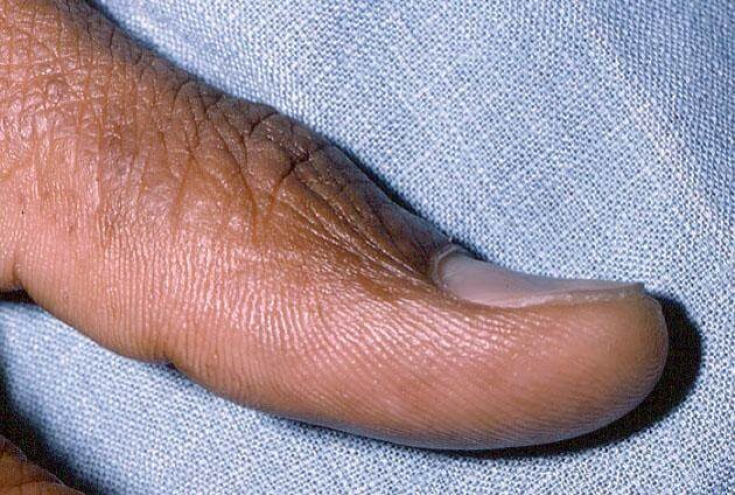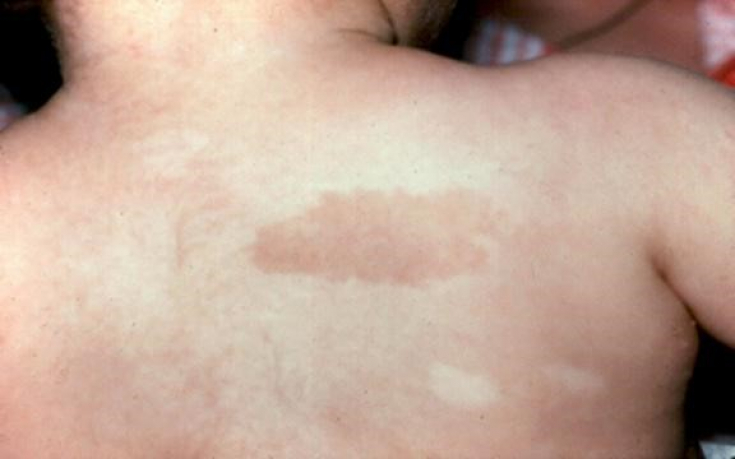Anemia is a pathological symptomatic complex characterized by a decrease in the number of erythrocytes and the concentration of hemoglobin in a unit of blood volume, which entails consequences due to a violation of the transport of oxygen to the tissues. Due to tissue hypoxia, regardless of the genesis and type of anemia, a number of changes occur, which also affects skin and mucous membranes. Consider the relationship of iron deficiency, pernicious, sickle cell and Fanconi anemia with dermatological aspects.
- Manifestations of iron deficiency anemia: skin, nails, hair
- Dermatological symptoms of pernicious anemia
- Skin ulcers in a sickle cell clinic
- Fanconi anemia and pigmentation disorders
Manifestations of iron deficiency anemia: skin, nails, hair
Iron deficiency anemia can cause changes in the appearance of the skin, mucous membranes, tongue, nails, and hair. With iron deficiency nails become brittle, longitudinal ridges form on their surface. There are changes in the nail plate with the development of koilonychia - a spoon-shaped bulge.
Iron deficiency anemia: causes, development, manifestations
It is believed that in iron deficiency anemia, due to tissue hypoxia, the formation of disulfide bonds is reduced, which, in turn, reduces the compliance of the nail plate.

Also, changes occur on the oral mucosa and on the tongue.
Therapy and prevention of iron deficiency
According to the study, out of 378 patients with iron deficiency, 14% had angular stomatitis, and almost half had changes in the papillae of the tongue: either to the filiform type or their atrophy.
Anemia of any origin will cause pallor of the skin and mucous membranes.
Women who donate blood experience diffuse thinning, hair loss, dryness, and an increased cross section, which is caused by depletion of iron depot.
Dermatological symptoms of pernicious anemia
With pernicious anemia, distinct skin changes are not observed. A dark red tongue that looks like a rock may be a late manifestation.
How to detect B12 deficiency anemia early
Excess formation of unconjugated bilirubin causes the skin and mucous membranes to take on a yellowish tint. 10% of patients with pernicious anemia have late onset vitiligo.
Follow us on Instagram!
According to studies, some patients with this pathology from Latin America showed the appearance of a reddish pigment on the hair, which disappeared after normalization of cobalamin levels. Two patients from Africa describe the appearance of blue pigment on the
The course of
sickle cell anemiamay be complicated by the occurrence of ulcers on the legs. Usually they are localized in the ankle on the medial and lateral surface. Size of ulcers varies from a few millimeters to large peripheral lesions. Ulcers occur spontaneously, there may be preliminary pain and sensation in this area. Based on clinical experience and epidemiological studies, the causes of leg ulceration can be divided into 3 categories:
impaired blood supply to the skin, local edema, and minor trauma. Frequent is the addition of secondary infection: mainly Staphylococcus aureus, Pseudomonas aeruginosa, Streptococcus and Bacteroides species. Other risk factors for leg ulcers in this pathology are male sex, the combination of HLA-B35 and HLA-Cw4, and antithrombin III deficiency.
Ankle ulcers are resistant to healing and tend torecurrence
in more than half of patients. Fanconi anemia and pigmentation disorders
The dermatological aspects of autosomal recessive
Fanconi anemiainclude several pigmentation disorders. Many patients present with "café au lait" skin patches, which most of them are present at birth.

, which may be acquired due to iron overload accompanying multiple blood transfusions, appears at an early age.
Follow us on Fanconi anemiamay also have hypopigmented skin.
Symptoms and management of aplastic anemia
The skin, its derivatives and mucous membranesare often the main, and sometimes the only, indicator of anemia, due to their extensive blood supply and sensitivity to changes in hemoglobin concentration and red blood cell count. It should be noted that the dermatological manifestations of anemia may differ depending on the etiology of the disease.
More interesting content is waiting for you on our





